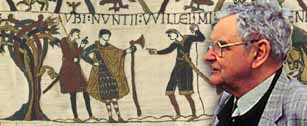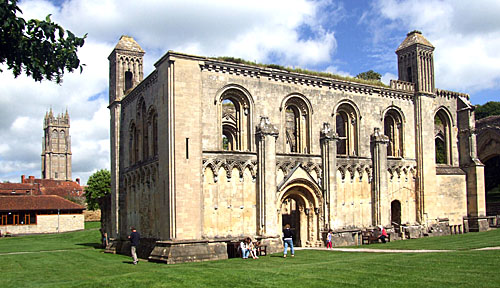 |
 |
|||
|
|
Glastonbury is unique, sacred, spell-binding. It is a small-town in Somerset, cradled in a cluster of hills that are all different shapes. The highest is the Tor, a whaleback formation with a tower on top, once part of a church dedicated to the Archangel Michael. Near the Tor is the smooth dome of Chalice Hill. Wearyall Hill is a long narrow ridge pointing toward the Bristol Channel. Windmill Hill, on the side facing the cathedral city of Wells, is less clearly defined and covered with houses. Below are the ruins of a great medieval abbey.
Early in the Christian era, the hill-cluster was nearly encircled with shallow water, the river Brue provided a deeper channel enabling sea-going craft to reach it. An old name for it is Ynys-Witrin, the Island of Glass; "island" because, from most angles of approach, it would have looked like one. A more famous name is Avalon, the Apple-place. In Celtic lore Avalon was an isle of enchantment.
This area was probably sacred long before Christianity. Around the sides of the Tor is a strange system of terracing. Much weathered and eroded, but still well-defined, it has been interpreted as a maze following an ancient magical pattern, which is found in Cornwall, Wales, Ireland, Pompeii, Crete and India, and even among the Hopi of Arizona, who call it the Mother Earth Symbol. If the maze on the Tor is real, human labour formed it four or five thousand years ago, during the period of vast ritual works that created Stonehenge and Avebury. There are grounds for thinking that the Tor would have been a sanctuary of Goddess-worship. To come down to a somewhat later time, archaeology has shown that toward the beginning of the Christian era, this neighbourhood became an important centre of Celtic population, with far-flung trade. The inhabitants lived on small artificial islands.
According to a much-loved legend, Christian Glastonbury began with the arrival of Joseph of Arimathea. He figures in the Gospels as a rich disciple who obtained the body of Christ and laid it in the tomb. Some say he was an older kinsman and had brought Jesus here as a boy, perhaps on a trading voyage to Britain. Reputedly, in the years after the Crucifixion, he came to this remote country on a mission with several companions. They made their home in Avalon and remained there as a community of hermits. An offshoot of the legend concerns a local variety of hawthorn known as the Glastonbury Thorn. It is said that Joseph planted his staff in the ground, and it became a tree that blossomed at Christmas. Descendants of a medieval hawthorn on Wearyall Hill actually do blossom at Christmas or thereabouts [This tree, planted in 1951, was vandalised in 2020 and removed in 2019]. While no other English hawthorn does this, there are some that do in the Middle East, including Palestine.
Whatever the facts may have been, the basic Joseph legend grew around something that was real and solid, an ancient church constructed of wattles - interlaced twigs or rods - with reinforcements of timber and lead. Bound with clay, wattle-work can be a stalwart material. It was used by early settlers in Wisconsin, and the remains of a wattle structure can be seen at New Harmony, Indiana, among the buildings in a community founded by the philanthropist Robert Gwen.
In the centuries after Britain broke from the Roman Empire, a group of Celtic British monks lived beside Glastonbury's small wattle church. It may already have been so old that no one knew who the builder was. Chroniclers decided eventually that it was Joseph of Arimathea, and that idea was the nucleus of the tale of his coming to Glastonbury. There were other stories connecting him with Britain, but no one knows which came first, or why such an unlikely person was ever thought of. The belief may reflect a lost tradition. At any rate, the site of the "Old Church" came to be known as "the holiest earth of England," where the Christian Faith was first planted. Today, the Lady Chapel among the ruins marks the place.
Hard evidence is lacking. Archaeologists have found traces of Christian settlement at least as early as the sixth century, on the Abbey site and on the upper part of the Tor. Gildas, a British author, seems to mention the Old Church about the year 530. Hermits may have lived hereabouts farther back, and there was some kind of Roman presence. But the more distant past is lost in obscurity. Those who wish to believe in Joseph are free to do so. Certainly, after the Gospel incident, history says nothing about his later life anywhere else.
When Christian Glastonbury began, most of the people of what is now England were British Celts, ancestors of the Welsh. But the pagan Anglo-Saxons, ancestors of the English, moved in from across the North Sea and gradually overran the country. At first, they wiped out whatever Christian institutions they found. However, their advance slowed down. The West Saxon kingdom of Wessex did not expand far enough to absorb Glastonbury until the middle of the seventh century. By then its kings were Christians, themselves, and they took over the British community peaceably. At Glastonbury, as nowhere else in England, we have a major instance of Christian continuity right through from Celtic times. As one historian has put it, the Saxon kings made the place a temple of reconciliation between previously hostile peoples. Its monastery grew into an abbey of the Benedictine Order. The greatest abbot, St. Dunstan, in the tenth century, started the drainage of the still-waterlogged country round about, embanking the river to prevent flooding. He launched the restoration of learning and religion in England after the Norse destruction of monasteries and monastic schools. His successors continued the reclamation of most of the territory down to the Bristol Channel, and protected it with sea-walls, so that it is now farming land.
Medieval Glastonbury played a part in the making of the legends of Arthur. Joseph of Arimathea, or a companion of his, was said to have brought the Holy Grail, the wonder-working vessel of the Last Supper, to Britain. From a first Avalonian resting-place, it had been removed to a mysterious castle, and, four hundred years later, many of Arthur's knights rode out in quest of it. The King himself had at least one personal connection with Glastonbury: he had besieged it to rescue Guinevere from an abductor, and visited the Old Church when the matter was settled.
In 1191, the monks of the Abbey claimed to have found his grave in their cemetery. Guided by a hint from a Welsh bard, they had dug down and discovered a stone slab. Under it was a cross of lead with a Latin inscription saying "Here lies buried the renowned King Arthur in the Isle of Avalon." Digging farther down, they had unearthed a coffin made from a hollowed-out log. Inside were the bones of a tall man who appeared to have been killed by a blow on the head, because the skull was damaged. Some smaller bones were taken to be Guinevere's. Modern excavation has shown that the monks did dig at a place south of the Lady Chapel, and did find an early burial [A 2015 reassessment of the excavation noe disputes this]. Most historians would deny that the bones were Arthur's, and dismiss the inscribed cross as a fake. But some have been willing to accept the identity as possible, even probable.
Throughout the Middle Ages the Abbey was growing. Its main church, nearly 600 feet long, was the largest in England after St Paul's Cathedral in London, with space for thousands of pilgrims on the principal holy days. The Abbot was Chief Justice in central Somerset, and the people for many miles around were his tenants. The Abbey maintained a school, and one of the finest libraries in England. It flourished until 1539, when Henry VIIl's policy of dissolution caught up with it. The last abbot, Richard Whiting, was convicted on trumped-up charges and hanged on the Tor, and his Abbey was dissolved like the rest.
Surveying this long record, we can see that Glastonbury has been a place of great beginnings. It has a strange vitality. Its Christian community, if not literally the first in Britain, was the first that survived, carrying on without a break from early times. It brought together Celts and Saxons; in a symbolic sense, the United Kingdom was born here. It was the fountainhead of cultural recovery in the aftermath of the Norse. Its legends were at the roots of the national saga of King Arthur.
The Abbey's downfall looked like the end. The buildings passed into private hands, and a succession of owners, who had no interest in preservation, used them as a quarry for saleable stone. Yet after all, Glastonbury was not dead, or reduced to a country town like many others. According to tradition, in 1587 an old man named Austin Ringwode, who had formerly been employed by the Abbey, prophesied on his deathbed that Glastonbury would be reborn and then "peace and plenty would for a long time abound." The rebirth began (if in ways that Austin Ringwode hardly foresaw) in the twentieth century. The extraordinary spell of the place began to work again.
Several things happened. The Abbey's last owner put it on the market, and the Church of England acquired it and has looked after it ever since. Each summer Anglican and Catholic pilgrims gather in thousands. Other developments were due to people with interests that were more secular, or, if religious, frequently offbeat and eccentric. In the 1920s, Glastonbury was the venue of the first major English festival of music and drama, founded by the operatic composer, Rutland Boughton, with support from celebrities such as George Bernard Shaw and Sir Thomas Beecham. Rutland Boughton's festival was the ancestor of others at Bath, Malvern, and elsewhere. Later came the establishment of a trust to preserve what is believed to be an ancient sacred spring, mentioned in one of the Grail stories and now called Chalice Well. The Chalice Well Garden is a famous meeting place for visitors from many countries, with a variety of interests. Later again came a surprising discovery of Glastonbury by the alternative society, the so-called hippies. The "Glastonbury Fayre" in 1971 was a sort of mystical Woodstock. After much strife and controversy, it is still repeated in most summers and attracts tens of thousands, though, of course, it has changed considerably.
Today, Glastonbury's role as a spiritual focus outside the churches is shown in a restored community centre, in a special-interest Library of Avalon, in healing clinics, in New Age conference rooms. Numerous tourists and seekers converge here especially from America. Some of the developments may look odd, but they cannot be ignored, and they involve many people of goodwill and intelligence. For a long time, "straight" and "alternative" elements in the town were sharply divided. The summer of 1996, however, may resolve some of the divisions with a new festival commemorating Rutland Boughton and bringing together musicians, artists, authors and others from different strata of the population. Is the reborn Glastonbury taking coherent shape? It may well be.
Click here for an Introduction to Geoffrey Ashe. David Nash Ford was formerly history editor for the now defunct online British history magazine, britannia.com.
|
|||
| © Geoffrey Ashe 1995. All Rights Reserved. | ||||





 Magical Glastonbury
Magical Glastonbury